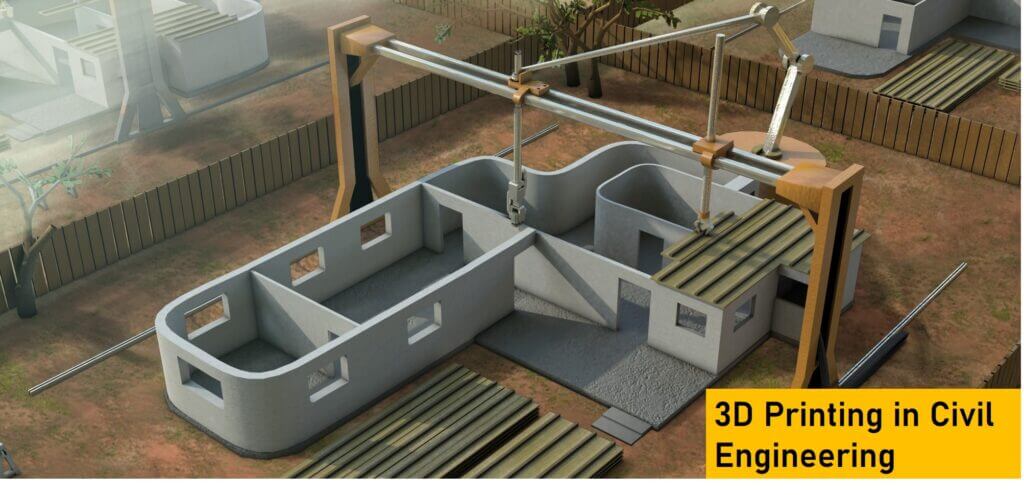Companies and startups in the civil engineering industry are primarily involved in the designing, construction, maintenance, and management of infrastructure. Often bloggers ignore civil engineering while listing technology-driven industries. But civil engineering companies, like enterprises in other sectors, have already gotten started with Industry 4.0 by leveraging new-generation technologies.
Additive manufacturing or 3D printing is one of the Industry 4.0 technologies transforming the civil engineering industry sectors. Most civil engineering firms these days leverage polymer and metal 3D printing technologies to reduce the time and cost required to construct complex structures. Also, they improve and maintain structures using advanced techniques based on 3D-printed models.
At the same time, Construction 3D printing creates opportunities for civil engineering companies to minimize environmental impact using sustainable materials and reduce material wastage. Many firms already use construction 3D printers to produce structures using renewable materials that last longer without requiring frequent maintenance.
We can understand the transformative impact of the Industry 4.0 technology by discussing some of the important use cases of 3D printing in civil engineering.
Some of the Groundbreaking Applications of 3D Printing in Civil Engineering
Faster Construction
Construction 3D printers create structures by depositing material layer by layer. Hence, they create construction components faster than conventional construction methods. Civil engineers have the option to choose from construction 3D printers driven by various technologies, including material extrusion, powder binding, or additive wielding.
Also, they can create structures using a variety of materials – polymer, metal, cement, and concrete. Civil engineers these days speed up infrastructure development by combining the right construction 3D printing machines and materials. We can cite 3D-printed buildings and bridges as one of the most visible applications of 3D printing in civil engineering.
Lower Construction Costs
In addition to reducing construction time, 3D printing technologies create opportunities for civil engineers to curtail construction costs significantly. Civil engineering firms can invest in construction 3D printers to eliminate the need to deploy additional laborers.
The decrease in manual labor helps them to avoid spending money to ensure occupational safety. At the same time, 3D printing technologies reduce construction costs significantly by minimizing material wastage and facilitating material recycling.
Complex Design Structure
Conventional construction methods make it challenging for civil engineers to design and build complex surfaces. Design freedom is one of the key advantages of 3D printing technologies. Civil engineers can design structures with complex shapes and intricate designs using 3D modeling software. They can further alter and finetune the digital model regularly without putting in extra time and effort.
Construction 3D printers enable civil engineers to convert digital designs into real-time construction components in a short amount of time without escalating costs. Many civil engineers these days switch from conventional construction techniques to 3D printing to design complex structures.
3D-Printed Structures
At present, civil engineers use construction 3D printers to build construction components like walls and frames. After 3D-printing the wall or frame they install electricity and plumbing separately. But there are many structures that are built piece by piece using 3D printers.
For instance, civil engineers in China have built a bridge in China by integrating 3D-printed concrete units. Likewise, civil engineers have built houses, offices, and hotels in various regions using construction 3D printers. Many civil engineering firms these days create new use cases by 3D-printing structures according to the varying requirements of clients.
Durable Structures
In addition to building infrastructure, civil engineering firms have to focus on making the structure durable. Conventional construction methods make it difficult to improve a structure by evaluating individual construction components. But 3D printing enables civil engineers to build structural elements separately.
Civil engineers can assess the concrete during the initial stages of construction. They can further refine the material, experiment with other materials, or change the way components are integrated based on the initial results. Civil engineering firms invest in the construction 3D printers to make durable structures that do not require expensive maintenance.
Sustainable Homes
Most owners these days opt for sustainable homes to protect the environment. In addition to using energy and resources efficiently, they want to build structures using organic and renewable materials. In addition to supporting conventional concrete and cement, new-generation construction 3D printers support a wide range of renewable and recyclable materials.
Civil engineers use 3D printers to build sustainable homes for customers without increasing construction time and cost. Also, they can make the homes energy-efficient by experimenting with various designs and shapes. Civil engineers already use construction 3D printers to build structures using renewable materials like mud, raw earth, and bamboo.
New Maintenance Techniques
3D printing technologies reduce maintenance costs by facilitating durable structure construction. At the same time, civil engineers leverage 3D printers to maintain buildings, roads, and bridges using new techniques. For instance, they improve the quality of roads by replacing heavy materials with asphalt, tar, and other lightweight materials supported by construction 3D printers.
Likewise, civil engineers replace specific components of older structures with 3D-printed construction components. Leading civil engineering firms invest in research and development (R&D) to create new maintenance techniques and methods by leveraging various 3D printing technologies.
Disaster Relief Shelters
Government agencies often find it challenging to provide secure and private accommodations to citizens after major disasters. They can provide people affected by major disasters with clothing, blankets, mattresses, and food items in a short amount of time.
But they have to explore ways to reduce construction time and cost of disaster relief shelters. Civil engineers help government agencies build disaster relief shelters in a short amount of time using 3D printers. They leverage construction 3D printing technologies to build eco-friendly and cost-efficient shelters in days after disasters.
Conclusion
While discussing 3D printing applications in civil engineering, we should remember that construction 3D printing technologies evolve consistently. The new-generation construction 3D printers help civil engineers build entire structures and construction companies accurately. Also, they enable civil engineers to experiment with a wide range of renewable and sustainable materials. That is why; the worldwide construction 3D printing market has been growing steadily.
About Aurum3D
We are amongst the major 3D printing service providers in Bangalore, India. We have been providing CAD modeling service, rapid prototyping services and custom 3D Printing services to many major industries including Civil engineering. Please feel free to get in touch with us for your custom needs, our 3D printing solutions experts will get back to you within one business day.

